Now, on the TRON network, users can easily achieve optimal Gas fee experiences with the two major features of JustLend DAO: "Energy Rental + GasFree."
As the world's largest stablecoin network, TRON carries about 60% of stablecoin trading volume. According to an August CoinDesk research report, in a survey of 50 countries, 35 directly listed TRON as the preferred blockchain for stablecoin payments. This global prevalence means that every change in on-chain Gas fees captures the attention of users worldwide.
At the end of August, TRON welcomed the largest fee optimization since its mainnet launch: "Energy," as a core component of TRON's Gas, saw its unit price drop from 0.00021 TRX to 0.0001 TRX, a reduction of nearly 60%. At the same time, a quarterly dynamic adjustment mechanism was introduced to ensure that fees can flexibly adapt to ecological demands. This significant adjustment quickly ignited the crypto community, and "How to achieve optimal Gas fees on TRON?" became a hot topic of discussion.
As the official lending platform of the TRON ecosystem, JustLend DAO is committed to "reducing users' on-chain costs" and has launched two key cost-reduction solutions: Energy Rental Service allows users to rent energy on demand without long-term TRX staking, directly reducing the Gas cost of each transaction; GasFree Smart Wallet Function completely breaks the traditional limitation of "must use native assets to pay Gas fees," allowing users to directly use transfer tokens (like USDT) to cover fees, significantly simplifying the on-chain transfer process.
Now, on the TRON network, users can easily achieve optimal Gas fee experiences with JustLend DAO's "Energy Rental + GasFree" features, without worrying about the reserve of native tokens or incurring high fees, truly enjoying the convenience and affordability of on-chain interactions.
TRON's Energy Mechanism and "Energy Rental Business": The Resource Allocation Logic Behind Low-Cost Interactions
In terms of Gas fee management, the TRON network employs a unique "Bandwidth + Energy" dual resource model. This allows for differentiated resource allocation for various on-chain operations, enabling developers to achieve precise cost control and forming a core advantage distinct from other public chains, especially suited for high-frequency, small-amount, and complex on-chain interaction scenarios, such as DeFi and GameFi.
The two correspond to different resource needs for on-chain operations: Bandwidth can be seen as the basic resource of the TRON network, primarily used to measure the storage and network resource consumption of transactions. All on-chain operations require bandwidth and can be completed solely with it; Energy, on the other hand, is more like an advanced resource, specifically supporting operations related to smart contracts, such as DeFi calculations, NFT minting, TRC20 token creation, and complex DApp interactions, all of which rely on Energy.
In simple terms, basic on-chain operations like TRX transfers, voting, and staking do not require calling smart contracts and can be completed with bandwidth alone; however, using a DApp (like borrowing TRX on JustLend DAO) involves contracts, thus requiring a combination of "Bandwidth + Energy" for payment.
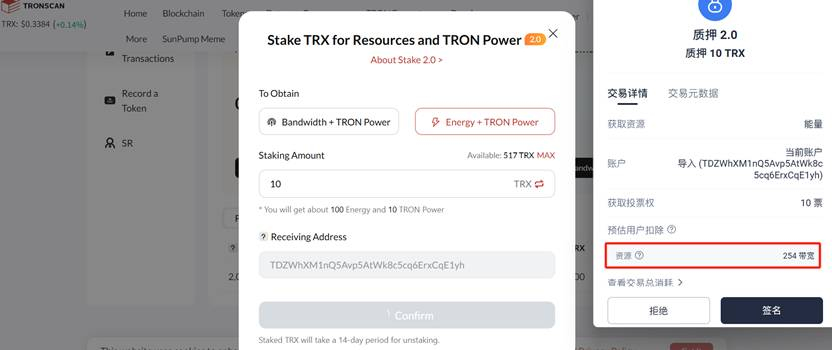
【Staking TRX only consumes bandwidth】
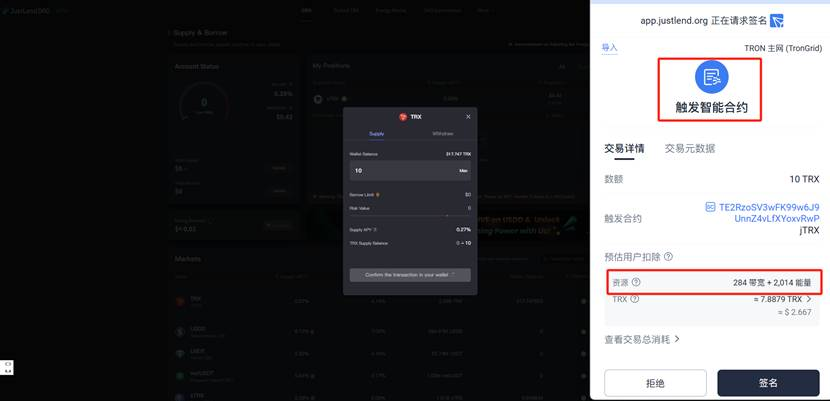
【Using JustLend DAO to store TRX triggers a smart contract, requiring both Energy and bandwidth.】
This "Bandwidth + Energy" dual resource model design is the biggest difference between TRON and EVM networks like Ethereum, BNB Chain, and Base. In EVM networks, all operations are uniformly priced according to Gas fees, regardless of whether they are simple transfers or complex smart contract calls. Miners prioritize transactions with higher Gas fees, which can lead to sharply rising costs during network peak times, even for small transfers, with fee fluctuations greatly exceeding expectations. In contrast, TRON's separation of bandwidth and energy cleverly avoids these issues: simple transactions rely on bandwidth, while complex contract operations are charged based on energy. This not only ensures fairness in contract execution but also makes costs more transparent and predictable, preventing ordinary users from being deterred by high costs and avoiding unnecessary resource waste during complex operations.
In terms of acquisition, bandwidth and energy are both related and distinct: both can be obtained by staking TRX, but bandwidth provides a daily free quota of 600 units, sufficient to cover daily transfer needs. If the free quota is exhausted, users can either choose to stake TRX for bandwidth or directly burn TRX to purchase it, with the price per unit of bandwidth consistently fixed at 0.001 TRX. Energy, however, has no free quota; every interaction related to contracts requires consuming energy, with the amount consumed being directly proportional to the complexity of the contract. Therefore, the unit price of energy directly determines the cost of using DApps, with each transaction prioritizing the use of energy already available in the wallet address. If insufficient, TRX needs to be burned to obtain energy.
As the TRON ecosystem flourishes (e.g., growth in USDT circulation, increased DApp interactions), energy consumption has been rising year by year, while the rising price of TRX also drives up energy costs. To reduce network Gas fees, TRON has made two significant reductions in energy prices since last September, each time exceeding 50%: first, the price per unit of energy dropped from 0.00042 TRX to 0.00021 TRX last September, and most recently, on August 29 of this year, the energy price was reduced from 0.00021 TRX to 0.0001 TRX, directly lowering the energy cost of smart contract operations by 60%. A quarterly dynamic adjustment mechanism was also introduced, where super representatives will optimize the unit price each quarter based on TRX prices and network activity indicators to ensure costs align with ecological demands.
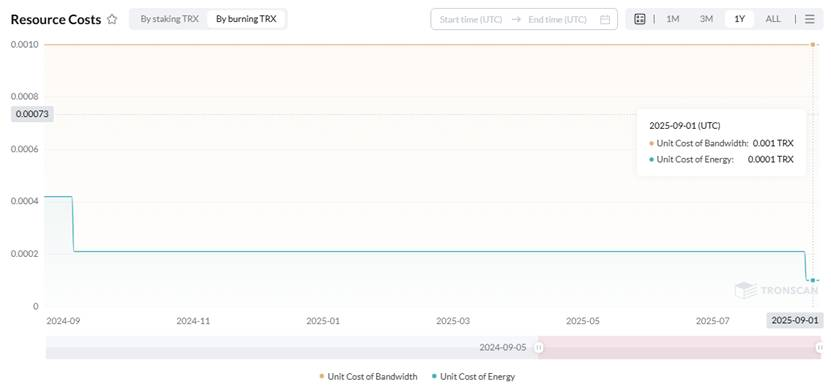
Currently, users can obtain energy mainly through three methods:
First, by staking TRX, energy is allocated daily based on the proportion of staked TRX to the total staked amount across the network. For example, on September 5, staking 1 TRX would yield 10 units of energy;
Second, by burning TRX to purchase energy, with the current energy unit price at 0.0001 TRX;
Third, by renting, temporarily using idle energy staked by others. For example, on JustLend DAO, using 2.6 TRX can rent 100,000 energy, sufficient for two transaction needs.
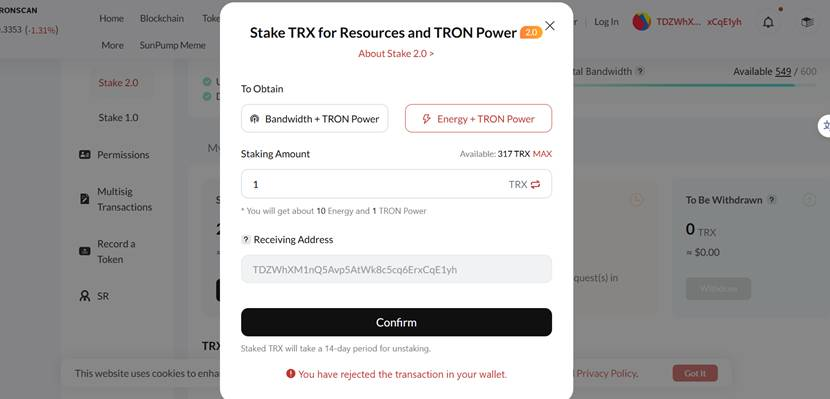
【Method 1: Staking TRX to obtain energy】
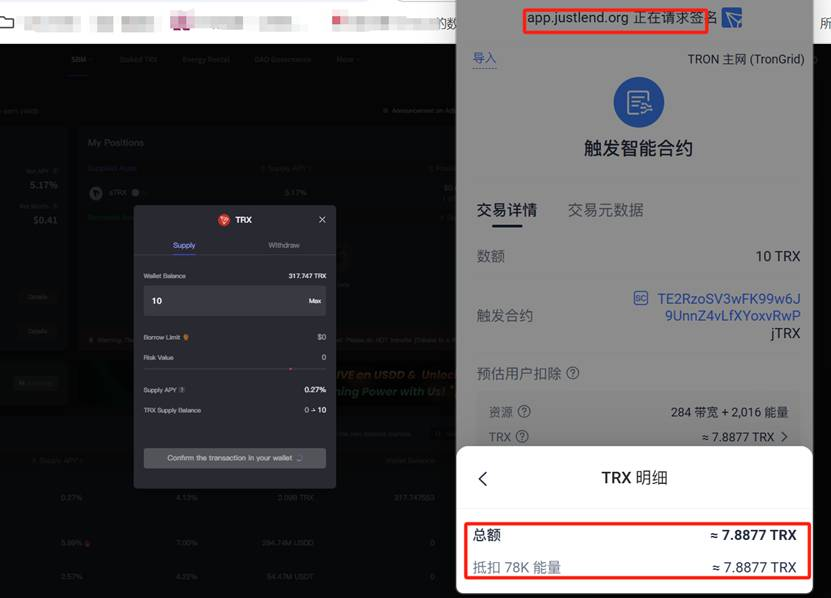
【Method 2: Directly burning TRX to obtain energy】
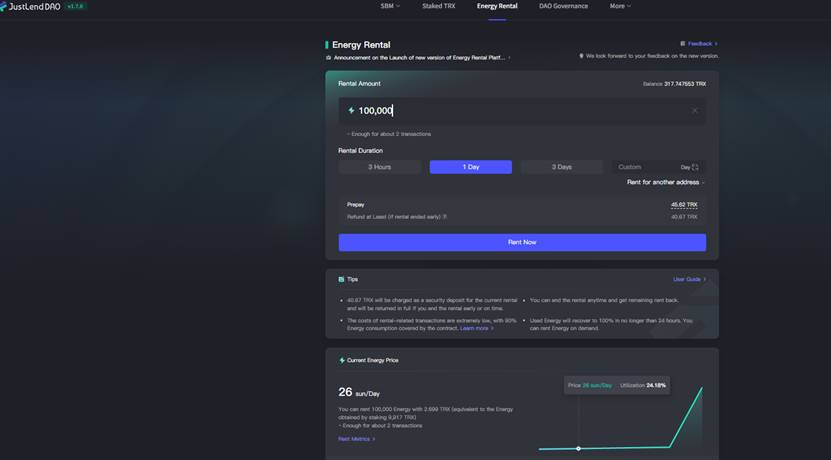
【Method 3: Renting energy】
Among these, the most noteworthy is "Energy Rental," a unique economic ecosystem within the TRON ecosystem, whose core relies on the shared nature of TRON's energy: TRX staking users can share their energy with other addresses, granting any user the right to "temporarily use others' idle energy." In the rental model, users do not need to stake large amounts of TRX long-term; they can obtain the corresponding amount of energy on demand by paying a small rental fee, meeting short-term on-chain operation needs.
Whether for personal temporary transfers of USDT, team contract development, or frequent contract interface calls by project parties, the "use as needed" rental model is flexible. This rental model achieves a win-win situation of "cost savings for users and profit for stakers." For on-chain users, there is no need to lock up TRX long-term; by renting energy on demand through the rental platform, they can easily complete short-term operations (such as participating in DeFi mining or minting NFTs), saving on the cost of capital occupation and significantly lowering the entry barrier for using complex DApps. For TRX stakers, by renting out their daily idle energy, they can earn rental income, transforming "staking TRX" from a mere "ecological contribution" into a dual value of "contribution + profit," greatly enhancing capital utilization efficiency.
Currently, a large number of professional energy rental platforms have emerged in the market, including the Energy Rental service launched by JustLend DAO, the official lending platform of the TRON ecosystem, as well as professional third-party rental platforms like Catfee and TRONEnergy. These platforms accurately match supply and demand, providing diverse service models such as "per-use rental" and "customized on demand," allowing idle energy to break through the limitation of "only personal ownership" and promoting efficient circulation within the ecosystem, further releasing resource value.
Today, the energy rental business has become a highly distinctive and vibrant financial scenario within the TRON ecosystem, reducing on-chain participation costs for ordinary users, activating idle assets for stakers, and enhancing the overall efficiency of TRX staking through efficient resource allocation. From the perspectives of user experience, asset value, and ecological circulation, it collectively strengthens TRON's core competitive advantage of "low cost and high vitality."
JustLend DAO's Official Energy Rental Service: A Core Tool for Saving Over 70% on Single Gas Costs on TRON
Currently, on the TRON network, whether for ordinary users performing low-frequency operations or project parties, developers, and traders needing high-frequency contract calls, obtaining energy through rental is the optimal solution. Compared to directly consuming TRX to obtain energy, the rental model can help users save about 70%-80% in costs for each smart contract operation (such as transfers, minting, and lending).
The TRON ecosystem lending platform JustLend DAO was the first to launch the energy rental service (Energy Rental) in 2023. With advantages of "no need to stake, safe and flexible, and controllable costs," it has become a core tool for users to reduce on-chain costs and is currently the largest energy rental channel on the TRON network.
Currently, the energy rental market is still in its early development stage, and ordinary users often face concerns about "the security of third-party platforms and the lack of transparency in pricing details." As the official lending application of the TRON ecosystem, JustLend DAO has locked crypto assets worth over $8 billion in Total Value Locked (TVL). Its energy rental service comes with a "safe and reliable" trust foundation, along with transparent service fees with no hidden costs, directly connecting to the TRON mainnet, making it the "safe preferred platform" for users to obtain energy.
According to data from the official website, JustLend DAO's energy rental service provides over 50 billion units of energy daily, with daily rented energy exceeding 10 billion units, and a total of 68,300 users participating.
The operation logic of JustLend DAO's energy rental service is very clear. Users only need to click a few times to quickly complete the rental process, with no complicated steps involved. Specifically, the operation is divided into the following three major steps:
1. Fill in the rental data: rental amount, rental duration, rental address.
Rental amount refers to the quantity of energy required, with a minimum rental unit of 100,000 (note that a single USDT transfer requires about 120,000 energy, and users can match as needed);
Rental duration supports hourly or daily rentals, with a maximum single rental period of 30 days. Users can choose based on their operation frequency; for example, for high-frequency interactions in a single day, they can choose "1 day," while for long-term project development, they can choose "30 days";
Receiving address is the target address to which the energy will be allocated. If renting for oneself, this does not need to be filled in; if renting for someone else, the corresponding address must be accurately entered.
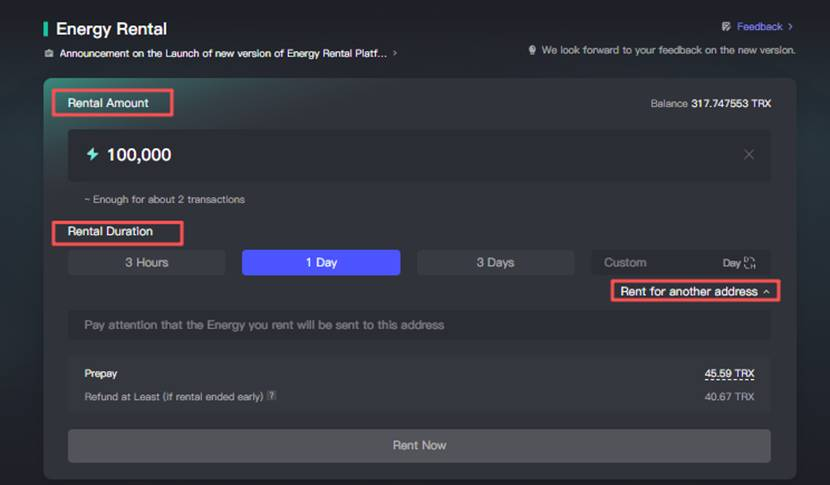
2. Submit the rental order and pay the advance payment: Renting energy uses a "prepayment model," requiring payment of three parts: energy rent (core cost), deposit (refundable after the rental ends), and penalty (a security deposit to avoid violations). All fee details are real-time transparent, with no hidden costs.
For example, renting 100,000 units of energy for 1 day requires a total prepayment of 45.5 TRX.
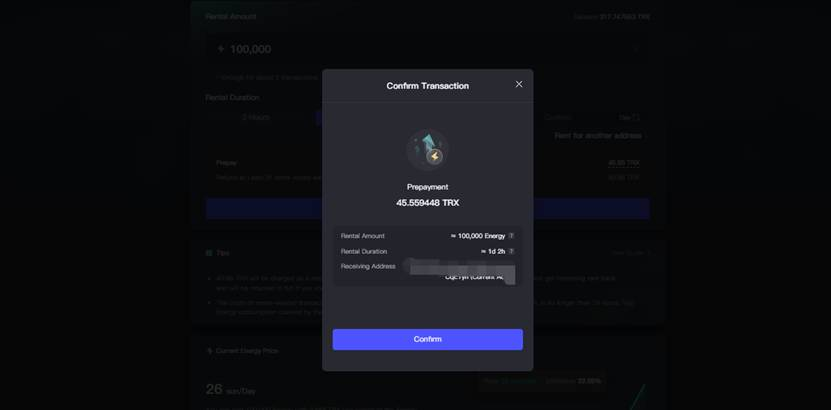
3. End the rental and refund the deposit: After the rental is completed, users can manage their orders in real-time on the "Energy Rental Interface": supporting refunding the rent (ending the rental early), extending the rental period (additional fees required), and checking remaining energy and rental duration.
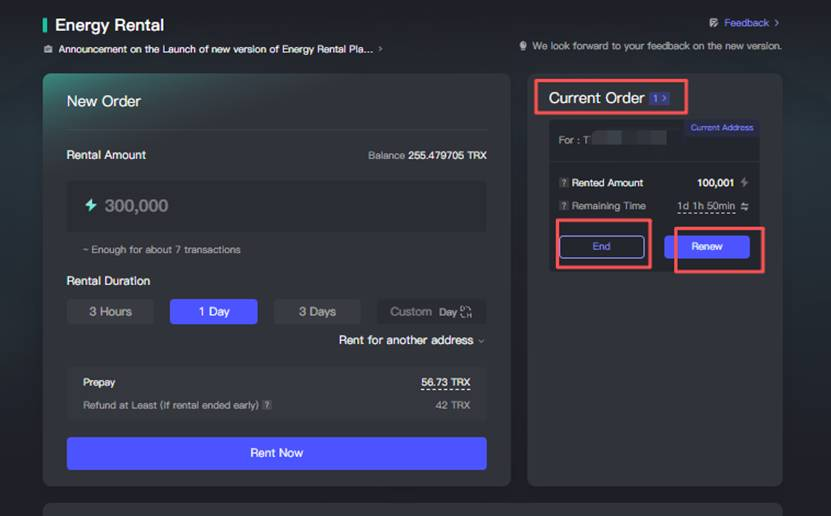
Friendly reminder: If only a single transaction needs to be completed, it is recommended to refund the energy immediately after the operation to avoid incurring additional costs from idleness; if daily transactions are frequent (such as multiple DeFi operations each day), it is advisable to choose a 30-day long-term rental.
From a cost perspective, the advantages of JustLend DAO's rental service are particularly significant: taking the common USDT transfer on TRON as an example, directly burning TRX requires an energy cost of about $4.3, while renting energy through JustLend DAO only costs $1.17, saving over $3 per transaction, with a cost reduction of more than 70%.
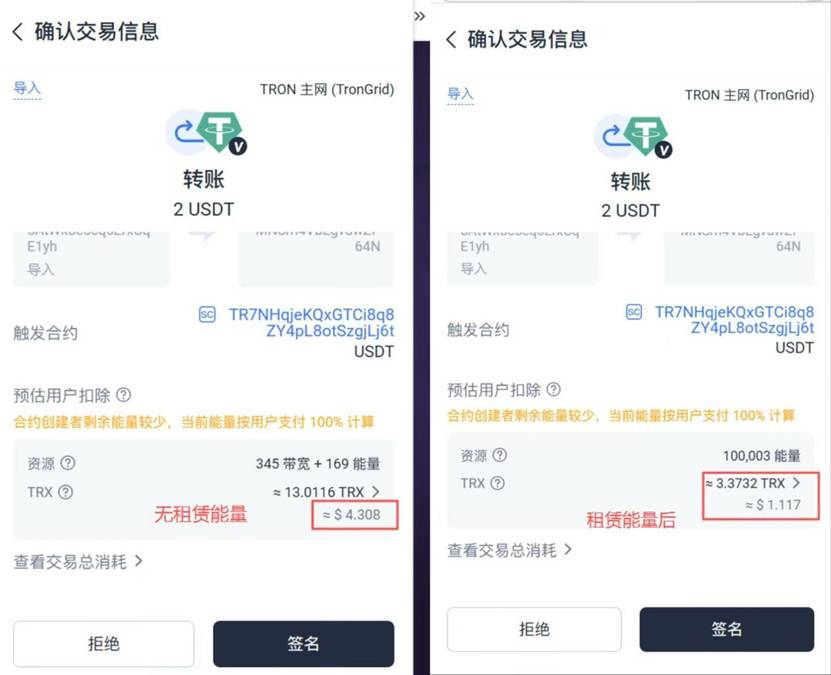
【Cost comparison of USDT transfer without rented energy vs. after renting energy】
From the above operation process, it can be seen that JustLend DAO's energy rental has three core advantages:
First, no locking required, flexible funds. Users do not need to stake large amounts of TRX long-term to obtain energy; instead, they can "rent as needed," renting the corresponding amount based on actual demand, avoiding the opportunity cost of long-term capital occupation, especially suitable for temporary energy needs, such as single NFT minting or short-term DeFi interactions.
Second, easy operation, supports multiple scenarios. This service is open to all TRON users, supporting "one-to-many rentals," allowing users to rent energy for their own address or on behalf of others, meeting the needs of individuals, teams, and project parties.
Third, controllable costs, high-frequency friendly. Having energy can directly offset the Gas fees for smart contract operations. For high-frequency trading users, such as GameFi players and DeFi arbitrageurs, long-term rentals can continuously compress costs, avoiding the problem of "accumulating high TRX burning fees."
More importantly, with the TRON energy unit price dropping by 60% on August 29, JustLend DAO responded on September 1 by reducing the "basic rental tax rate from 15% to 8%." Users can now enjoy the dual benefits of "reduced energy base unit price + lowered rental tax rate" when renting energy on JustLend DAO.
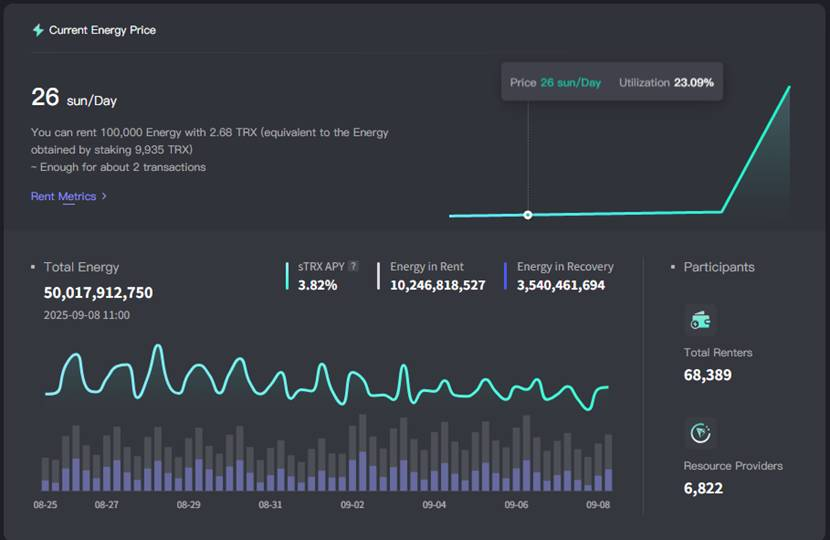
Currently, the energy price of JustLend DAO's energy rental service is about 26 SUN/day, allowing users to rent 100,000 units of energy for only 2.62 TRX (equivalent to the energy obtained by staking 9935 TRX), sufficient to cover two contract transactions, further amplifying the cost advantage.
JustLend DAO Launches GasFree Smart Wallet: Pay Gas Fees Directly with Transfer Tokens, Making Crypto Transfers as Simple as Sending Messages
In enhancing the user experience for on-chain interactions, JustLend DAO not only has the energy rental service to help reduce Gas costs but also launched the innovative GasFree smart wallet feature in March this year, further addressing the core pain point of crypto transfers: users no longer need to hold native network tokens to pay Gas fees (such as TRX); whether transferring TRC20 or ERC20 tokens, the fees can be directly deducted from the transferred tokens. This mechanism breaks the traditional limitation of "must use native tokens to pay network fees," providing a frictionless new solution for token transfers, making crypto transfers more aligned with everyday usage habits.
The ultimate vision of GasFree goes beyond this: it aims to allow users to easily complete asset transfers on the same interface, whether using TRON, Ethereum, or other blockchains—without needing to understand the underlying technical details or prepare various native tokens in advance. Ultimately, GasFree aims to make "crypto transfers as simple as sending emails," while ensuring the security of a decentralized environment and the interoperability required for global payments, allowing blockchain transfers to truly integrate into daily life.
This innovative design of "paying the corresponding fee for the token being transferred" simplifies the originally cumbersome process of "exchanging native tokens → initiating transfer → paying Gas" into "directly initiating transfer → deducting corresponding tokens as fees" in two steps. This not only significantly improves operational efficiency but also greatly reduces the learning curve for new users, making crypto transfers more intuitive and user-friendly. Whether for beginners or experienced users, everyone can enjoy a seamless asset transfer experience without worrying about "gathering native tokens to pay Gas."
In April this year, TRON founder Justin Sun stated at the "BUIDL 2025" crypto conference in Hong Kong that for individual users, GasFree means they no longer need to worry about paying and calculating Gas fees; for institutional users, it is a significant solution, as many institutions wish to integrate blockchain technology for efficient settlement but are reluctant to hold highly volatile cryptocurrencies directly. GasFree allows institutions to send and receive funds solely through addresses without needing to touch native crypto assets, significantly lowering the usage threshold, promoting broader ecological access, and facilitating the large-scale adoption of blockchain technology.
In the month GasFree launched, the TRON ecosystem wallet TronLink was the first to integrate this feature, allowing users to simply open the TronLink app or browser extension, click GasFree, and immediately experience this new transfer method. Currently, this feature supports TRC20-USDT transfers and will expand to more asset types in the future. Additionally, to enhance user experience, JustLend DAO has simultaneously launched a 90% fee subsidy policy. With the support of this subsidy policy, users only need to pay about 1 USDT for each USDT transfer. It is important to note that when using the GasFree smart wallet for the first time in TronLink, a one-time activation fee of only 1 USDT is required.
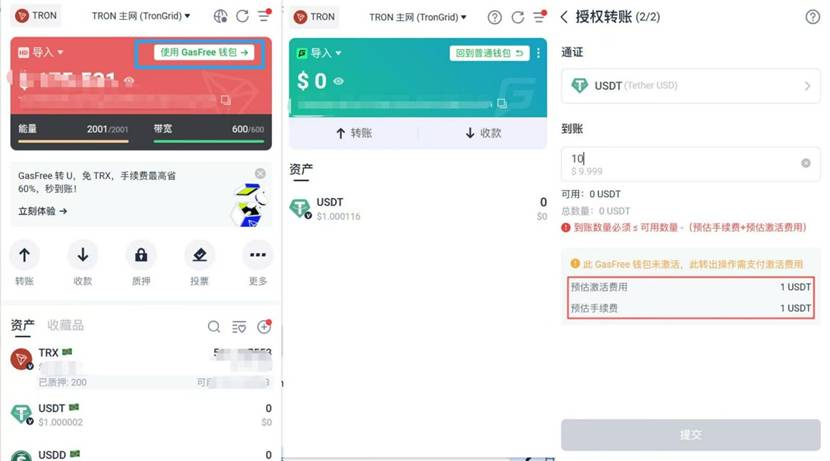
【Using GasFree to transfer USDT only requires paying 1 USDT】
As of now, dozens of mainstream wallets, including imToken and Klever, have integrated GasFree, and more platforms are expected to support it in the future, further expanding its usage range.
From a practical perspective, GasFree has already demonstrated strong ecological value: as of September 8, this feature has completed a cumulative transaction volume of up to $15.8 billion, with over 750,000 transactions, saving users nearly $2.2 million in Gas fees, intuitively confirming its role in "cost reduction and efficiency enhancement."
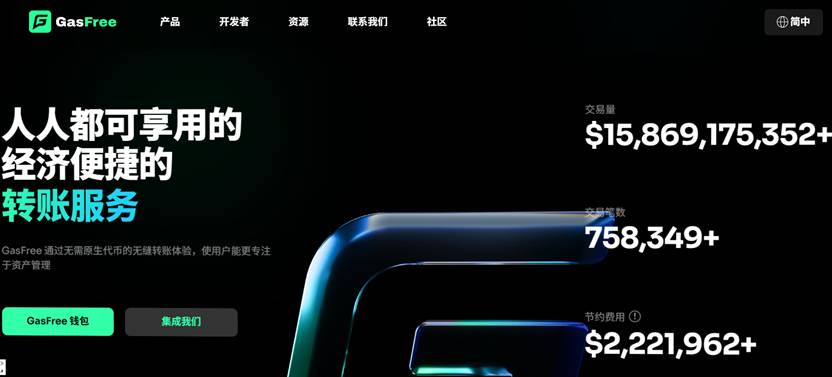
In addition to the innovation in payment experience, GasFree also excels in technical adaptability: it is compatible with any TRC20 or ERC20 token, does not rely on the implementation logic of specific tokens, and provides standardized interfaces and smart contract templates, allowing project parties to achieve "one-click deployment" of a Gas-free transaction system, significantly lowering the threshold for new tokens to access the ecosystem and further expanding the application coverage and applicable scenarios of GasFree.
To comprehensively reduce the usage costs for users and developers, GasFree has recently officially launched the Developer Center, which provides a one-stop energy management service tool covering "energy cost prediction, automatic energy rental, optimization suggestions," helping developers effectively control energy consumption when integrating GasFree features, simplifying the development and deployment process of DApps, allowing developers to focus more on product innovation without excessive concern about underlying network energy costs, achieving a dual optimization of "convenient transfers for users + efficient development for developers."
The launch of GasFree marks a solid step forward for the TRON ecosystem in continuously innovating and improving user experience. With the integration of more wallets and platforms, users will enjoy lower transfer costs and more convenient operational processes, which not only optimizes the interaction experience within the TRON ecosystem but also provides a practical reference for the inclusive development of the entire blockchain industry through the innovative model of "breaking the dependence on native tokens."
免责声明:本文章仅代表作者个人观点,不代表本平台的立场和观点。本文章仅供信息分享,不构成对任何人的任何投资建议。用户与作者之间的任何争议,与本平台无关。如网页中刊载的文章或图片涉及侵权,请提供相关的权利证明和身份证明发送邮件到support@aicoin.com,本平台相关工作人员将会进行核查。




